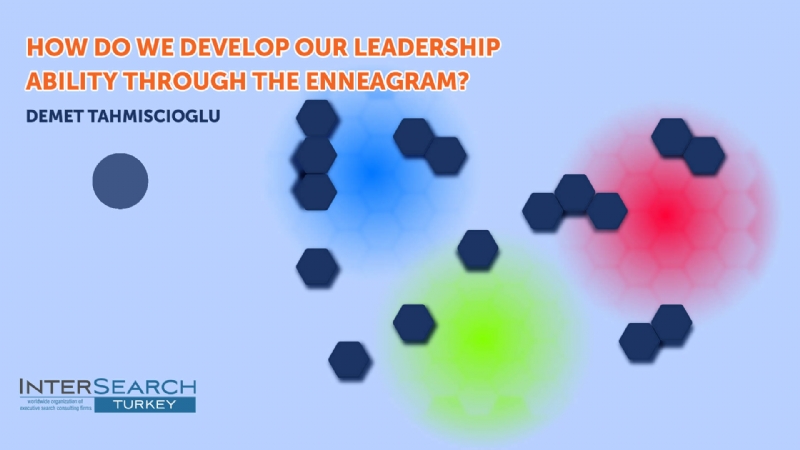
How do We Develop Our Leadership Ability through the Enneagram?
Demet Tahmiscioğlu
Synopsis
Many personality models support professionals for understanding themselves better and to identify their strengths and blind spots, but none of them does this as good as the Enneagram. Thanks to the Enneagram which reveals our inherent system of instinctual values and the nine strategies we use to satisfy those values. In this piece, we will look into our instinctual biases and how they effect our leadership style.
People with all sorts of personalities can be successful at work. Our personality style does not determine our success, and while it is often the source of many of our strengths, it can create blind spots and obstacles that can hold us back. So how can we leverage the strenghts of our personality and more-quickly recognize blindspots and obstacles and overcome them?
Many personality models support professionals on this issue, but Enneagram is one step ahead, thanks to its two dimensional structure which comprises both the instinctual biases and the nine strategies. In other words, the Enneagram helps us understand what is important to people and how they go about getting those things that are important to them. This information is valuable for business life, where team work and project management can be issues of personality conflicts.
If you want to know people in your work life better, work more effectively together and lead teams that achieve business results, you should know the Enneagram. “Enneagram” literally refers to a diagram with nine intersecting lines creating nine points enclosed in a circle (“ennea” is Greek for nine, “gram” for drawing). This diagram is used to represent nine personality styles and the interrelationships among those styles.
There are two dimensions of personality described by the Enneagram—our inherent system of instinctual values and the nine strategies we use to satisfy those values.
What Are the Instinctual Biases?
Dimension 1 of the Enneagram personality model is the three instinctual biases. The instinctual biases are deeply ingrained tendencies to find certain aspects of life more important than others and to focus our attention accordingly. These instinctual concerns fall into three broad domains.
We all pay some attention to each of these domains, but we tend to focus on them unequally and we are biased toward one of the domains noticeably more than the others.
What we value influences what we focus on at work. These instinctual biases have a dramatic effect on how we interact with coworkers, how we lead, how teams function, and more.
Those domains are:
- Preserving: Focused on “nesting and nurturing” and on ensuring that fundemental survival needs are met for things like food, water, comfort, shelter, and overall safety from harm.
- Navigating: Focused on “orienting to the group” and on building alliances, creating trust and reciprocity, and understanding how oneself and others fit into the group.
- Transmitting: Focused on “attracting and bonding” and on passing genes, beliefs, values, interests, and worldview to others in order to make them carriers of that information.
How Do Instinctual Biases Effect Our Leadership Style?
People with different instinctual biases will focus on different tasks and objectives and we are often surprised when people place their priorities somewhere other than where we do. Such value discrepancies are often a significant source of miscommunication and conflict in the workplace. Understanding the influence of the instinctual biases can help us reduce them.
There are different leadership behavior regarding each instinctual domain.
- Preservers are naturally drawn to “the nuts & bolts”; structures, processes, and procedures, playing the devils’s advocate, finance/budgeting, organization of materials, etc. Their strengths are administration and processing data, predicting problems, creating processes. Cautious and conservative; prefer proven methods to risky experimentation.
- Navigators are naturally drawn to culture: interpersonal dynamics and organizational culture; building teams. Their strengths are building consensus and shaping group identity, focusing on the big-picture and strategic thinking.
- Transmitter’s are naturally drawn to “sizzle”; presentation/promotion of self and products, creating network and attracting others, competing. Their strenghts are charisma, building relationships with customers, channel partners, and strategic allies; selling inside and outside the organization, inspiring workforce.
Each leadership style also has weaknesses, we’re not very good at what we neglect.
- Preservers may be too introverted; focus on task rather than interpersonal issues. Lack of charisma; cautious rather than risk-taking; detached rather than inspirational.
- Navigators may neglect administrative details, processes, and procedures; making difficult personnel decisions (e.g. addressing underperformance), performance discipline.
- Transmitters may focus on charisma at expense molding organizational culture, neglecting career development of subordinates, self-focus may put own interests before company/employees.
You can disvover your instinctual priorities and the strategies to get them, develop your personal and team efficiency and leadership abilities through our “Personalities@Work” program.